PLUS: Breaking the mold of "Oscar style"
Custom ceramics add a new dimension to plating
How not to write a cookbook
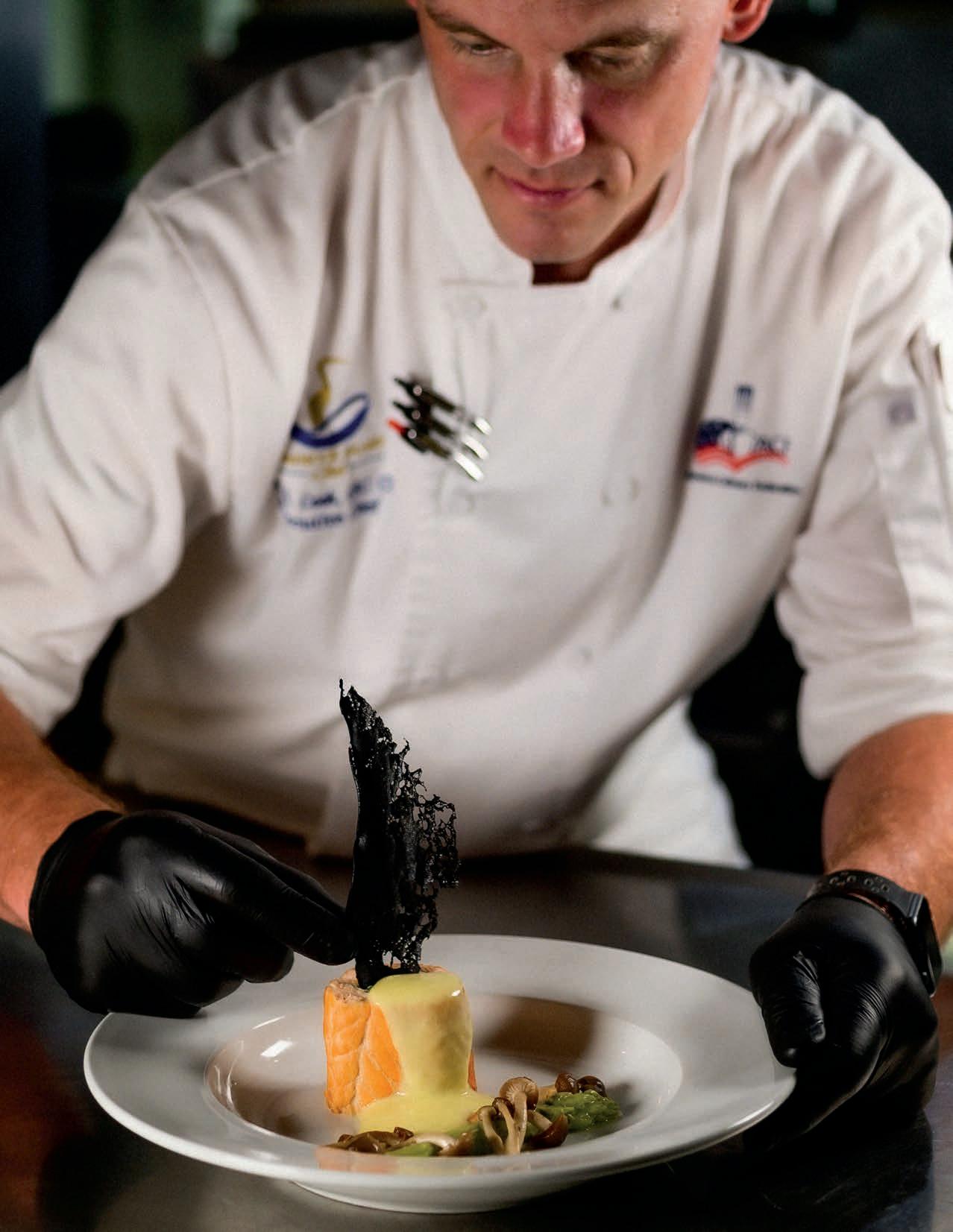
SEPTEMBER/OCTOBER 2019




IMMERSION BLENDERS 8-QUART STAND MIXERS COMMERCIAL BLENDERS Commercial Kitchens are tough environments even by our legendary standards. That’s why KitchenAid® Commercial was born. Now the brand you grew up using can grow with your business. KitchenAid Commercial equipment is NSF certified and designed for you to power your passion. ®/™ ©2019 The design of the stand mixer is a trademark in the U.S. and elsewhere. All rights reserved. SDO19167 2000 North M-63, Benton Harbor, MI 49022 PH: 855-845-9684 www.kitchenaidcommercial.com email: commercial@kitchenaid.com
FEATURE STORY
24 Chapters on a Mission
Charitable events and membership development are just some of the inspiring acts performed every day by ACF chapters around the world.
DEPARTMENTS
14
18
20
Main Course
Chefs offer tricks for experimenting with seasonal finds during the transition to fall. Plus, how not to write a cookbook (page 45).
Pastry
New flavors of colorful couvertures let pastry chefs play with chocolate.
On the Side
More chefs are working with potters for hand-crafted plateware that makes an impact.
22 Classical vs. Modern
Creamy, crab-topped salmon Oscar gets the modern treatment.
32 Management
Charity partnerships let chefs give back through food. 34 Health

Chefs face more challenges to keep guests safe amidst the growing number of food allergies. Plus, why the world’s best bartender got sober.
Cover image by Miguel Emmanuelli
WEARECHEFS .COM 3
Lance Cook, CEC, CCA, plates a modern salmon Oscar.
IN EACH ISSUE 4 President’s Message 6 ACF On the Line 8 News Bites 12 Advocacy 44 The Quiz 46 A Look Back SPECIAL SECTION 38 ACF National Convention: Orlando
Editor in Chief
Jocelyn Tolbert
Creative Services Manager
David Ristau
Assistant Editors
Heather Henderson and Amelia Levin
Graphic Designer
Armando Mitra
Sales Specialist
Dave Merli
Director of Marketing and Communications

Renee Brust
American Culinary Federation, Inc.
180 Center Place Way St. Augustine, FL 32095 (800) 624-9458 (904) 824-4468 Fax: (904) 940-0741 ncr@acfchefs.net • www.acfchefs.org
Board of Directors
President
Stafford DeCambra, CEC®, CCE®, CCA®, AAC®
Immediate Past President
Thomas Macrina, CEC, CCA, AAC
National Secretary
Mark Wright, CEC, AAC
National Treasurer
James Taylor, CEC, AAC, MBA
American Academy of Chefs Chair
Americo “Rico” DiFronzo, CEC, CCA, AAC
Vice President Central Region
Steven Jilleba, CMC®, CCE, AAC
Vice President Northeast Region
Barry R. Young, CEC, CCE, AAC
Vice President Southeast Region
Kimberly Brock Brown, CEPC®, CCA, AAC
Vice President Western Region
Robert W. Phillips, CEC, CCA, AAC
Executive Director
Heidi Cramb
The National Culinary Review® (ISSN 0747-7716), September/October
2019, Volume 43, Number 5, is owned by the American Culinary Federation, Inc. (ACF) and is produced 6 times a year by ACF, located at 180 Center Place Way, St. Augustine, FL 32095. A digital subscription to the National Culinary Review® is included with ACF membership dues; print subscriptions are available to ACF members for $25 per year, domestic; nonmember subscriptions are $40. Material from the National Culinary Review®, in whole or in part, may not be reproduced without written permission. All views and opinions expressed in the National Culinary Review® are those of the author and do not necessarily reflect the views and opinions of the officers or members of ACF. Changes of mailing address should be sent to ACF’s national office: 180 Center Place Way, St. Augustine, FL 32095; (800) 624-9458; Fax (904) 940-0741.
The National Culinary Review® is mailed and periodical postage is paid at St. Augustine, Fla., and additional post offices.
POSTMASTER: Send address changes to the National Culinary Review®, 180 Center Place Way, St. Augustine, FL 32095.

ACFEF Students and Your Community
Take a deep breath. Can you feel it? That’s the invigoration that comes from another successful, record-setting ACF National Convention. Every time I attend, the motivation I get from the powerful speakers, challenging conversations, inspiring competitors and familiar faces reinforces my commitment to our ACF ohana, our ACF family.
This year at National Convention, during our first-ever Women Leaders Symposium, I had the pleasure of being a panelist with a group discussing the topic of mentorship. It got me thinking about how we all need mentors, no matter where we are on our paths. As I begin my second term as your National President, I want the current membership of the ACF to be the mentors that the culinary industry needs so that we can grow this organization for the next generation.
With that goal in mind, the ACF is proud to announce that for the first time ever, the ACF has launched complimentary membership for all ACFEF-accredited secondary students. In addition, students at our post-secondary ACFEF-accredited programs will be able to become ACF members at a discounted rate of nearly 40% off.
“I had to pay full price when I was a young culinarian! Why shouldn’t young chefs today have to do the same?” I hear your concerns and I hope you hear mine: We cannot sustain the ACF without these young chefs. Welcome them and even better, visit your neighborhood ACFEF accredited programs and urge administrators and educators to take advantage of this opportunity. I want to see new faces, young members at our events next year, and I know you do too.
It is a fact that our chapters are the best recruiting tool we have and this issue of the National Culinary Review recognizes some of the great work they do, including bringing young chefs into the fold. I visit ACF chapters across the country, and these members are on a mission to grow, to teach, to further the culinary profession and to do good in their communities. (By the way, did you know that the opportunity to serve their community is a top reason a young professional engages with an organization?)
If your chapter isn’t as active as some of the groups highlighted in this issue, then I encourage you to take your inspiration from these pages and become the leader they may need.
Bring the ACF into your community, and bring your community into the ACF.
Stafford T. DeCambra, CEC, CCE, CCA, AAC National President American Culinary
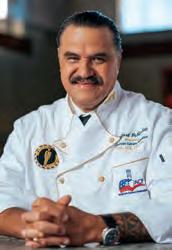
4 NCR | SEPTEMBER /OCTOBER 2019
Contact me at sdecambra@acfchefs.net or follow me on Facebook @stafforddecambra and Instagram @sdecambra
Federation
Estudiantes de ACFEF en su comunidad
Respire profundo. ¿Puede sentirlo? Es la revitalización que nos trae la última exitosa Convención Nacional de ACF que batió todos los récords. Cada vez que asisto, la motivación que me dejan los impactantes oradores, las desafiantes conversaciones, los competidores inspiradores y los rostros conocidos refuerza mi compromiso con nuestra ohana, la familia de ACF.
Este año en la Convención Nacional, durante nuestro primer Simposio de Mujeres Líderes, tuve el placer de ser panelista en un grupo que debatió el tema de las tutorías. Me hizo pensar en cómo todos necesitamos mentores, sin importar en qué etapa del camino nos encontremos. Al comenzar mi segundo mandato como su Presidente nacional, quiero que los miembros actuales de ACF sean los mentores que la industria culinaria necesita para que podamos hacer crecer esta organización para la próxima generación.
Con ese objetivo en mente, ACF se enorgullece en anunciar que, por primera vez, ha lanzado una membresía complementaria para todos los estudiantes de secundaria acreditados por ACFEF. Además, los estudiantes de nuestros programas postsecundarios acreditados por ACFEF podrán convertirse en miembros de ACF con una tarifa con casi 40% de descuento.
“¡Yo tuve que pagar el precio completo cuando era un joven estudiante culinario! ¿Por qué los jóvenes chefs no deberían hacer lo mismo hoy?" Escucho sus inquietudes y espero que usted escuche las mías: Sin estos jóvenes chefs, ACF no podría sostenerse. Hágalos sentir bienvenidos y, aún mejor, visite los programas acreditados por ACFEF de su vecindario e incentive a los administradores y educadores a aprovechar esta oportunidad. Quiero ver caras nuevas, miembros jóvenes en nuestros eventos el próximo año, y sé que usted también.
Es un hecho que nuestras delegaciones son la mejor herramienta de reclutamiento que tenemos, y esta edición de la National Culinary Review reconoce algunas de las grandes iniciativas que realizan, incluida la incorporación de jóvenes chefs. Visito las delegaciones de ACF en todo el país, y estos miembros tienen la misión de desarrollar, enseñar, promover la profesión culinaria y hacer el bien en sus comunidades. (Por cierto, ¿sabía que la oportunidad de servir a su comunidad es una de las principales razones por las que un joven profesional se relaciona con una organización?)
Si su delegación no es tan activa como algunos de los grupos destacados en esta edición, le recomiendo que se inspire en estas páginas y se convierta en el líder que su delegación podría necesitar.
Acerque a ACF a su comunidad, y acerque su comunidad a ACF.
Conference On-Demand allows anyone to watch and learn from the inspiring speakers on the ACF events main stage, from anywhere, anytime. With these new tools, we are able to reach more chefs wherever they are. Visit acfchefs. org/OLC to start watching today.
2020 ACF conference registration is open now! Register early to get the best price at acfchefs.org/events.
WEARECHEFS .COM 5 | President's Message | Un Mensaje Del Presidente |
What’s Cooking on We Are Chefs this month
Read these recent digital-only articles (and new stuff each week!) on wearechefs.com






























How Instagram is changing the restaurant industry (and 3 reasons chefs should have an account)
New chefs enter a world where social media has a huge impact on everything, from the dishes they design to the way they respond to customer feedback.
What Exactly is Kombucha?
As with almost any modern cure-all, there is some disagreement in the medical community about whether the drink provides any real health benefits.
An American chef takes in the Icelandic food scene
Not typically known for its exciting cuisine, the restaurant scene of Iceland’s capital has blossomed in recent years.
10 Facts About Being a Food Stylist

It’s important for chefs interested in food styling to know the realities of this sometimes surprisingly tough profession.
Sure, digital is environmentally friendly... but paper smells better.




A digital subscription to NCR is included with ACF membership, but members can now get a one-year print subscription for just $25! Visit acfchefs.org/ncr to get yours today.
Follow the ACF on your favorite social media platforms:




@acfchefs @acfchefs
@acf_chefs

















@acfchefs American Culinary Federation

Twitter question of the month:















What’s your favorite music to listen to in the kitchen?
Tweet us your answer using the hashtag #ACFasks and we’ll retweet our favorites.
Our favorite #acfchefs Instagram photo of the month:
Tag your Instagram photos with #acfchefs and you could see your image here in the next issue of NCR.
The Culinary Insider, the ACF’s bi-weekly newsletter, is a great source of timely information about events, certification, member discounts, the newest blog posts, competitions, contests and much more. Sign up at acfchefs.org/tci

6 NCR | SEPTEMBER /OCTOBER 2019 | On the Line |
195 COUNTRIES. 25 LANGUAGES. OVER 150 YEARS.



Since the first bottle of TABASCO ® brand Original Red Sauce was handcrafted in 1868, it has been the pepper sauce loved by people around the world. From our home on Avery Island, Louisiana, to every corner of the globe, it’s the bold choice for flavor enthusiasts looking to make their meals as unique as they are.












TABASCOfoodservice.com











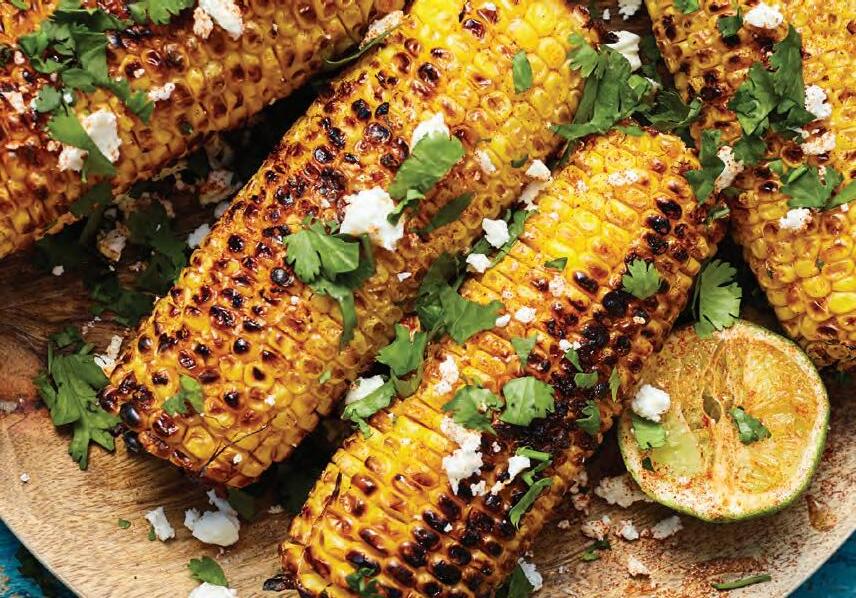
TABASCO® Sauce is distributed to 195 countries and territories around the world and labeled in 25 languages and dialects. ©2019. TABASCO and the DIAMOND and BOTTLE LOGOS are trademarks of McIlhenny Company, Avery Island, Louisiana, USA 70513.
Don’t Take This for Granted
American Culinary Federation Education Foundation, through the Chef & Child initiative, is offering ACF chefs and chapters grant funding to support nutrition outreach activities in their communities. Outreach activities must align with the Chef & Child mission to education children and families in understanding proper nutrition. Activity examples and outlines are available at acfchefs.org/CCFPrograms.


Grant opportunities are available for events (i.e. cooking demonstrations, tastings), as well as programs (i.e. after-school programs, cooking classes). Grant funds can be used to purchase food, supplies and incentives for the planned activity. Deadline to apply is January 31, 2020. cvent.me/zgNZw
Get Involved
Childhood Nutrition Day, celebrated on or around Oct. 16, focuses on the need for education about childhood hunger, proper nutrition and obesity issues. Since the campaign’s launch in 1995, hundreds of chefs across the nation have participated in events within their local communities to feed hungry children, and foster and promote awareness of proper nutrition.
“Looking at the happiness and joy coming from the kids over healthy ingredients brought back memories of my childhood,” says Sam Spencer of the Gulf Coast Culinary Association. “Sometimes we ask why we do what we do, but when we see those smiles it makes it worthwhile … A healthy chef can make a healthy smile.”
We encourage all of our chefs to organize a Childhood Nutrition Day event in your local community, such as a food drive or a healthy cooking demonstration. For more information please visit acfchefs.org/childhoodnutritionday.

Competitive Advantage
In 2020, competitions for both regional and national awards will be held over just five days at ACF National Convention: Dallas. Each region will have one full day to compete. At the end of the day, the highest-scoring competitors from each region will be announced as regional winners. After all four regions have competed, point totals will be tallied and the competitors and teams with the highest overall score will be our national winners. Visit acfchefs.org/awards to read more details and to fill out an application to compete.

8 NCR | SEPTEMBER /OCTOBER 2019 | News Bites |
Lunch Lines
Every day, 30 million children eat school lunch, and 70 percent of those students qualify for free or reduced (F/R) priced meals. With only $1.25 to spend per student meal, it becomes challenging for schools to serve real, healthy food that meet USDA guidelines. The Chef Ann Foundation (CAF), a nonprofit founded in 2009 by ACF member chef Ann Cooper, works daily to provide school communities with the tools, training, resources and funding that enables them to create healthier food and change lunchroom environments.
Salut
Nazim Khan, CEC, executive chef of Bryan Health, was the subject of a July article on klkntv.com detailing how he has partnered with a local farmer’s market in Lincoln, Nebraska to serve locally sourced food to the community.

CAF’s Real School Food Challenge to raise awareness for school food reform kicks off October 1. First launched in 2016, the challenge aims to demonstrate how great-tasting, healthy, and budget-friendly food can be easily made in school kitchens. “We believe every child deserves access to healthy delicious food every day in school so they can develop healthy eating habits to last a lifetime,” says Cooper. “We host these culinary challenges to help educate and inform the public about the importance of serving our children scratch-made meals in schools, and could not be more excited to see how our partner chefs use their culinary creativity to create meals for some of their most important guests ever — kids.”
Restaurant chefs will create meals that fit USDA guidelines and cost around $1.25 each, then add their dish to their menus, with proceeds going to the Chef Ann Foundation. The winning recipe will be selected by the Chef Ann Foundation based on creativity, presentation and scalability, and will be featured on the Foundation’s national school food recipe database for kids around the country to enjoy. chefannfoundation.org
In November 2018, ACF Middle Wisconsin Chefs Association raised $2,000 to benefit the Boys & Girls Club of the Wisconsin Rapids Area with a benefit dinner and raffle hosted by Fred Griesbach, CEC, AAC, assisted by students from Lincoln High School. Griesbach also received a service award for organizing the event. Competing against 35 other chefs, Debe Brady of University of Wyoming Dining Services won a silver medal in July’s National Association of College & University Food Services National Culinary Challenge.


In June, Michael Garbin, CEC, AAC, retired from his position as Executive Chef at the Union League Club of Chicago after over 26 years.


Chefs Vince Blancato and Ray Benton, CCE, HAAC, of the ACF Tampa Bay Chapter, were the subject of an article on suncoastnews.com detailing how they volunteer in elementary school gardens, helping teach children to tend and cook their own vegetables. These programs in three Florida counties are sponsored by the chapter through the ACF’s Chef & Child Initiative.
Christina Nicosia, CEPC, CCE has been hired as a culinary instructor at Ozarka College in Melbourne, Arkansas.
WEARECHEFS .COM 9
Don’t Miss a Moment
Did you miss one of our inspiring and educational events this year in Atlantic City, Minneapolis and Orlando? ACF Conference On-Demand is here to help. Watch recordings of all the main stage speakers from each of our 2019 events, right now. Videos of Gale Gand, Duff Goldman, Marco Pierre White and more are available for you to watch anywhere, any time. Buy the five-video package at cvent.me/VZvW0 or one video at a time on our Online Learning Center at acfchefs.org/olc.
Test Your Knowledge
What spice comes from the dark-brown pod of a tropical orchid? Know the answer? Then grab some teammates and compete in the ACFEF Culinary Knowledge Bowl!
"It encourages teamwork, learning, and passion throughout practices and during the competition week,” says Joanna Bryant, CCC, CCE, Knowledge Bowl coach at Grayson College in Denison, Texas. “Students are excited to gain more and more culinary knowledge throughout the process!"
In 2020, both regional and national competitions will take place at the ACF National Convention: Dallas, July 19-23, 2020. For more details, visit acfchefs.org/knowledgebowl.


Remembering Mr. Brown
“The idea for a permanent tribute to [former ACF Executive Vice President L. Edwin] Brown came to my mind after I was one of the speakers at his funeral. Ed was a very dear friend of mine and also everything to ACF. Without him, ACF would not have been what it is today,” says Francine Greff, HAAC. “I sent out an email to those people who felt the same as I did and John Folse picked up on it and said he would partner with me to raise funds.”
John Folse, CEC, AAC, HOF announced Greff’s idea to create a permanent memorial to Brown was announced at the 2018 National Convention. Over $20,000 in donations poured in from the floor.
At ACF National Convention: Orlando in August, we unveiled the brand new Corinthian marble bust of Mr. Brown that has been installed in the national office.

“At the [2018] convention, I stated that our thoughts were to have a bust made, do something for the National office and then make a donation to Team USA and that is what we did,” Greff says.
A video conferencing system was installed at the national office. In addition, a $10,000 check, made out to ACF Culinary Team USA (which Mr. Brown particularly loved), was presented to team advisor Thomas Macrina, CEC, CCA, AAC, on stage at Convention.
10 NCR | SEPTEMBER /OCTOBER 2019 | News Bites |
love proudly. eat classically. live deliciously.
























When you choose Prosciutto di San Daniele PDO, Grana Padano PDO and Prosciutto di Parma PDO, you show a passion for the Italian way of life that includes incomparably delicious, natural food that’s never mass-produced or processed. Each of these products carry the Protected Designation of Origin seal, the European Union’s guarantee of quality and authenticity, so you know they are from a speci c geographical region in Italy and are created using traditional techniques that have set the standard of culinary excellence for generations.








The content of this promotion campaign represents the views of the author only and is his/her sole responsibility. The European Commission and the Consumers, Health, Agriculture and Food Executive Agency (CHAFEA) do not accept any responsibility for any use that may be made of the information it contains.














































 CAMPAIGN FINANCED WITH AID FROM THE EUROPEAN UNION.
THE EUROPEAN UNION SUPPORTS CAMPAIGNS THAT PROMOTE HIGH QUALITY AGRICULTURAL PRODUCTS.
CAMPAIGN FINANCED WITH AID FROM THE EUROPEAN UNION.
THE EUROPEAN UNION SUPPORTS CAMPAIGNS THAT PROMOTE HIGH QUALITY AGRICULTURAL PRODUCTS.
NEW GENERATION
of the ACF
For the first time ever, ACF student membership is free to all junior and senior high school students attending ACFEF accredited programs. Program coordinators can sign up their students by providing us with just a few pieces of information. In addition, ACFEF-accredited post-secondary programs now have the option to provide ACF membership to their students at a reduced price.
WHO ARE THESE STUDENTS?
They care about the world and people around them. 60% of Generation Z (roughly 15-23 year olds) say they want their jobs to impact the world. And 26% of 16-19 year olds currently volunteer.
Source: Marketo, 2014
They want mentorship. Gen Z places a high value on mentorship. 33% rank it as the most important benefit an employer can offer, just a few percentage points behind health care.
Source: Door of Clubs, 2017
2,969
Current number of ACF Student Culinarian and Junior Culinarian members.
42,534
Number of students in ACFEF accredited secondary and post-secondary schools — in other words, the number of potential new members who will join our ranks thanks to this initiative.
WHAT CAN YOU DO?
Being a role model for professional values and standards.
Why are we doing this? Because we think it’s important. It’s important for young, aspiring chefs to have access to mentorship, education and job opportunities from professional chefs like yourself. It’s important that they see chefs don’t just cook. We give back to our communities. We compete. We support one another. And that starts with reaching out to young people and inviting them in. Perhaps they won’t be the only ones who learn a thing or two.
WHY DO WE NEED THEM?
“Protégés that receive career coaching and social support … are reportedly more likely to have high performance ratings, a higher salary and receive promotions. ... Organizations benefit as well, because protégés are more likely to be committed to their organization and to exhibit organizational citizenship behaviour.”
Source: The role of mentorship in protege performance, Nature, 2010
“Combining older and younger adults can also boost the cognitive performance of older adults, and foster prosocial behavior and a lack of egocentrism in younger adults. When older and younger people work together, fluency of thought for the older person can improve with only 30 minutes of interactions.”
Source: Harnessing the Power of a Multigenerational Workforce, SHRM, 2017
Mentorship and professional development are vital for students to stay on their career path. You can help them out by:
Welcoming local student members to your chapter meetings and support their growth & development through networking/collaboration.
Promoting the profession. Many secondary students still haven’t decided on a career path yet, but your influence can help them decide to pursue a careeer in the culinary field.
Welcome to the
"Generation Z Goes to College," a 2014 study, found that Generation Z students self-identify as being loyal, compassionate, thoughtful, openminded, responsible, and determined.
share generously. eat naturally. live deliciously.



When you choose Prosciutto di San Daniele PDO, Grana Padano PDO and Prosciutto di Parma PDO, you show a passion for the Italian way of life that includes incomparably delicious, natural food that’s never mass-produced or processed. Each of these products carry the Protected Designation of Origin seal, the European Union’s guarantee of quality and authenticity, so you know they are from a speci c geographical region in Italy and are created using traditional techniques that have set the standard of culinary excellence for generations.








THE EUROPEAN UNION SUPPORTS CAMPAIGNS THAT PROMOTE HIGH QUALITY AGRICULTURAL PRODUCTS.













































































CAMPAIGN FINANCED WITH AID FROM THE EUROPEAN UNION.
The content of this promotion campaign represents the views of the author only and is his/her sole responsibility. The European Commission and the Consumers, Health, Agriculture and Food Executive Agency (CHAFEA) do not accept any responsibility for any use that may be made of the information it contains.
Flavors of Fall
Chefs turn toward heartier dishes with local autumn ingredients and preserved summertime finds
 By Kathryn Kjarsgaard
By Kathryn Kjarsgaard
With an increased interest in specialty seasonal ingredients and easier access to farms and farmer’s markets, there is no need for restaurants to transition to a fall menu simply by adding a few pumpkin and apple dishes. Instead, many fall menus today highlight ingredients that showcase a wider array of seasonal fruits, vegetables and proteins as well as finds from the summertime harvest that can be easily dried or pickled.
Still, ever-changing growing seasons and weather do affect the availability and selection of ingredients in fall months, according to Shaun Brian Sells, executive chef of Parcel 32, Charleston, S.C.
“Chefs have to approach their fall menu differently depending on where they are located in the country,” he says. “I try to access the full seasonality of Charleston, and we use all local purveyors, farmers and fishermen and women.”
Leonard Hollander, chef/owner of Arbor in Chicago, spreads out the use of ingredients from the fall through the winter months.
“The biggest struggle is to avoid giving in to exhausting the larder,” he says. “There is a long winter ahead, and the ingredients get really thin so I try to avoid jumping into things too early in the fall.”
Changing it up
At Arbor, Hollander changes the menus quarterly, seasonally or even daily depending on the impact of the weather on harvests.
“I seek to not repeat,” he says. “I do revisit the ‘crush’ dishes of years past, but they are always viewed through a new lens.”
Sells, who sources many ingredients through GrowFood Carolina, a Charleston-based food hub that connects restaurants with 85 local farmers throughout South Carolina, changes menu items in twos and not all at once to avoid scaring away customers and keep things interesting in the kitchen.
14 NCR | SEPTEMBER /OCTOBER 2019 | Main Course |
Above: Local pickled vegetables at Parcel 32 in Charleston, SC
Opposite: Green tomato pie at Parcel 32
Photo credits: Spread: Andrew Cebulka
“You can go for two weeks with one seasonal ingredient, and then have summer squash for four months, so there is a lot of versatility,” he says. “By adding new dishes every two weeks, by the time you go through the seasons, you have gone through all the ingredients, trends and techniques.”
Perennial favorites
On fall menus, Hollander like to utilize squash, apples, pears and other seasonal produce.

“I enjoy the perennial and expected delights that we all get so excited about with fall produce and techniques like braising and slow cooking using these warming and richer foods,” he says. “Single-varietal apple and non-alcoholic pear ciders and the fun items and products that come from them allow you to see how the nuances follow through to the end product.”
Hollander says he leans heavily into cauliflower, celery root, mushrooms and heirloom squashes in the fall with favorite apples being Mutsu and Senshu. He also uses a lot of roasted nuts like hazelnuts, pecans and pistachios as well as fruits and herbs from the summer that have been dried.
WEARECHEFS .COM 1 5
In terms of protein, Hollander uses braising cuts, with oxtail and short ribs of beef and bison as autumn favorites. “I also love goat for fall, and I don't use it enough,” he says.

At Parcel 32, Sells can utilize vegetables like broccoli and cauliflower from summer through the fall, as they are ready for harvest in the South earlier in the season. “Some farmers get two or three harvests of these vegetables,” he says.
He also tries to be mindful of what people think of as seasonal. “I always use pumpkin, such as Hubbard or Kabocha squash, which I refer to as hard fall squash,” says Sells, who makes a silky pumpkin soup with an onion base, sofrito sauce, white wine, coconut milk, thyme and local ginger. It is topped with local yogurt and spiced pumpkin seeds.
Unexpected autumn ingredients
At Parcel 32, Sells uses many pickled ingredients to add interest and cut down
on food waste. “Pickling lets you preserve what is plentiful in the season,” says Sells. “You can also ferment items for hot sauce or make them into a miso or vinegar.”
He does a lot of foraging in the fall, particularly for chanterelles, and then, as the winter approaches, he plucks oyster and chicken of the woods mushrooms.
A favorite fall offering is tea timebrined chicken with cassava dumplings, which features pickled mushrooms, wilted kale and dumplings made with cassava. When it comes to proteins, Sells says he rotates fish seasonally, sourcing triggerfish and trout in the fall.
Fall desserts
Parcel 32 offers a selection of desserts with fall ingredients, such as zucchini dark chocolate cake with blackberry sauce. Sells says they offered a pumpkin blondie last fall, and this year may create a pumpkin panna cotta or curd.
“A real favorite of customers is our green tomato pie, which we offer in the summer and fall,” he says. “The flavor is like a green apple, and we spice it like an apple pie. We serve it with buttermilk ice cream on top.”
16 NCR | SEPTEMBER /OCTOBER 2019 | Main Course |
Kathryn Kjarsgaard is a freelance food writer based in Oak Park, Illinois.
Above: Duck & beets — peking duck leg confit, roasted golden beets, pickled chioggia beets, red beet soubise, frisée, walnut gremolata — at Arbor in Chicago










welbilt.com Welbilt offers a fully-connected kitchen to the world’s top chefs, premier chain operators and growing independents with industry-leading equipment and solutions. We provide integrated kitchen systems connected by KitchenConnect® and supported by KitchenCare® aftermarket parts and service. Our broad product portfolio of best-in-class equipment includes fryers, ovens, kettles/skillets, hot holding, ice machines, dispensers, refrigeration and walk-ins. BRINGING INNOVATION TO THE TABLE Follow us: See us @ #719 Contact for a demonstration 727-858-4218
CREATIVE COUVERTURES
Chefs experiment with new, intense flavors and vivid colors in the world of chocolate // By
 Robert Wemischner
Robert Wemischner
Like kids in a candy store (pun intended), pastry chefs are eagerly experimenting with the latest creations from chocolate companies: flavored chocolates (more properly called couvertures), which, by definition, must contain a minimum of 32 percent cocoa butter content. Here, flavor, color, texture and innovation are all wrapped up in an easy-to-use package — a boon to the often understaffed pastry chef.
Although quite different in composition, new lines of chocolate from Valrhona and Callebaut’s flavored callets allow chefs to amplify and contrast flavors in everything from mousses and bonbon fillings to vibrant plating sauces and accent glazes on pastries and cookies.
Valrhona’s line includes three flavors — strawberry, passion fruit and almond, each made with cocoa butter, sugar, added fat and flavorings. Yuzu and raspberry varieties are on the horizon. The passion fruit flavor is based on powdered passion fruit juice; the strawberry one gets its intense fruity flavor from freeze-dried strawberries. For the almond variety, defatted almonds are mixed with cocoa butter, sugar and lecithin.
“With its toasty flavor profile, it’s a bit like white chocolate aspiring to be milk chocolate when it grows up,” says executive pastry chef Miro Uskokovic of New York City’s Union Square Hospitality Group. “I like to use these as the basis for ganache filling in bonbons.”
Callebaut’s line also offers a range of flavors, including orange, lemon, cappuccino, honey, strawberry and lemon with the most recent additions being yogurty-tart Ruby made from pink-hued cacao beans and Gold, a pale, amber-colored couverture with caramel notes. In addition, they contain cocoa butter, which means that the callets can be more easily tempered. When properly done, the resulting shell of a confection or glaze on a
pastry or cookie made from these will have a snap and a shine — like all truly tempered chocolates have. As a bonus, many of these new lines of chocolate are also vegan, which allow pastry chefs and confectioners alike to appeal to that growing segment of the population.
David Chow, an artisanal chocolatier in Toronto, who creates seasonal collections as well as a core array of year-round confections, is very inspired by flavored chocolates. “I find that the Inspiration products react similarly to white chocolate,” he says. “I combine waffle cookies with the strawberry Inspiration as an accent and use this blend as a filling in my molded chocolates. I love the natural color that it brings to my fillings.”
Sean Considine, pastry chef of Jean-Georges restaurants in New York City, likes that many of the new flavored chocolates on the market are fat soluble. He often adds a bit of oil to thin them down, and then uses it in brushstrokes to complement the flavor of the main elements of a plated dessert. “I also like to use strawberry flavors as a filling for a pistachio financier, a rich slightly dense, sponge cake-based cookie, which is served as an after dessert mignardise plate at the restaurant,” he says.
18 NCR | SEPTEMBER /OCTOBER 2019 | Pastry |
Left: Passionfruit frozen parfait at Patrice Demers’ Patrice Pâtissier in Quebec. Opposite, from left: Tropical-flavored couvertures from Valrhona’s Inspiration line with passionfruit and berries; The vegan-friendly almond tart using Valrhona’s Inspiration line; both at Patrice Pâtissier.
Kriss Harvey, the creative mastermind behind andSons Chocolatiers in Beverly Hills, Calif., uses Callebaut’s Inspiration line to create a thin, shiny shell containing a nutted filling for her chocolate creations. These treats are created in a revolving angled pan in which the melted flavored couverture is gradually added to coat the centers, not unlike the process for making malted milk balls. With this product’s relatively high price point, Harvey likes to use it sparingly as an outer finishing layer on items that already feature other white or milk chocolate products.
Patrice Demers, creator-owner of namesake Patrice Pâtissier in Quebec, has made creative use of the Valrhona’s Inspiration line for a vegan-friendly, passion fruit and almond cream dessert, based on almond milk, pectin and a tropical flavored couverture. Demers also uses the flavored couvertures in a 2-to-1 ratio with cocoa butter for thinning out to coat frozen parfaits on a stick. Through his in-house research and development department, he has found that desserts based on the Valrhona line can be frozen with no change in texture or flavor intensity. This helps the production bakery turn out a wide variety of products without artificial flavors or colors daily. Both lines are sought by chocolatiers and pastry chefs wishing to add layers of flavor or complement the flavor of their base desserts.
Adding flavored couvertures to a crème anglaise or non-dairy base,
stabilized by gelatin or a seaweed-based setting agent (for vegan or vegetarian desserts) is a first step to many new wave desserts. Lightening the mixture with either an Italian meringue or whipped cream, or both, or even an aquafababased meringue made from the liquid used in canned legumes leads to a whole new world of fillings, verrine layers, puff pastry-based napoleons and so much more. The arrival of these new couverture products on the ingredients scene no doubt helps forward-thinking pastry chefs remain open to new ideas when it comes to creating arrays of sweets with new flavors and textures.
Robert Wemischner is a longtime instructor of professional baking at Los Angeles Trade Technical College and the author of four books including The Dessert Architect and Cooking With Tea. He also teaches a course in restaurant management.


WEARECHEFS .COM 1 9
The Perfect Plate
Plateware is the next avenue of customization
By Samantha Lande
It’s not surprising to visit a restaurant these days and learn that a chef has worked with local farmers, artisan bakers and other small purveyors to source their ingredients. Many chefs and restaurateurs also work with design firms to make sure the space has the right vibe and design. Lighting, colors and fabrics are all important considerations in creating the perfect restaurant space. But recently, chefs have been adding another layer of customization: the servingware on the tables.
Historically, chefs would get plates from a restaurant depot or big box store — often imported, generally very simple and stark white. It was pretty unheard of for chefs to have someone create custom serving pieces outside of the upper echelon of fine dining (for instance, Alinea started partnering with artist Martin Kastner back in 1998).

But times are changing and with chefs spending so much time crafting the perfect dish, it only makes sense that they’d want to put it on the perfect plate.
The process
“The process of working as a potter is a lot like that of a chef,” explains Keith Kreeger, who owns Keith Kreeger Pottery in Austin, Texas. He has an enviable roster of clients — Empellon in New York, Boka in Chicago, 610 Magnolia in Louisville and a dozen more. He takes the time to learn about how the chefs like to serve food, options of sizes, what kinds of plates and what they are

looking for. He often provides standard sizes, but does plenty of custom work as well, depending on the client’s needs. At the end of the day, Kreeger knows that his art is meant to be functional and he loves seeing food on his plates.
Working directly with an artisan gives chefs the ability to craft exactly what they need. Jay Lewis, chef and owner of Outpost Kitchen, a laid-back Australianstyle café in Costa Mesa, California, serves quite a few grain bowls and wanted something that would show off what was inside. He worked to create custom sizes that fall somewhere between a plate and a bowl — 8.5 inches with a 2-inch height — something he wouldn’t have been able to easily buy off the shelves.
Highlighting the food
Executive Chef Taylor Neary of Holmes just outside of Atlanta wanted to find a way to make his dishes really shine. “Any different textures and colors you can apply helps the food pop,” he says. He uses different color plates and often plays up the contrast between his food and the serving piece. He was able to find his potter, Noble Plateware, via Instagram and they spent a few months settling on colors, shapes and textures that would work for the restaurant. He doesn’t use specific plates for specific dishes but
20 NCR | SEPTEMBER /OCTOBER 2019 | On the Side |
Left: Keith Kreeger Studios Opposite, clockwise from top left: Keith Kreeger Studios; Salamat Ceramics bowls for Outpost Kitchen; Noble Plateware
Photo credits: Above: Kate LeSueur; opposite top left: Keith Kreeger; opposite bottom: Hollmes
rather plays around with the various colors. “So, one day pork belly may come out on a pink plate, another day a black plate. It adds a cool dimension to the dining experience,” he says.
Support local
For Lewis, choosing to work with an artisan made sense for other reasons, too. Sure, he wanted his food to “pop,” but he also found it equally important to support local artisans to emphasize that he is truly a community gathering spot. He does so not just with his plates, bowls and coffee cups but also with other artwork found within the restaurant. He partnered with Salamat Ceramics owner Monica Galan, a frequent customer of the restaurant, and already and they’ve formed a great partnership — he is having her design over 600 pieces for his next restaurant.

Durability and Cost
These hand-crafted plates may look significantly more unique than the typical dish, but do they hold up? Speaking with both potters and chefs, the answer is a resounding yes. They can go through industrial dishwashers thousands of times just like any other plate.


“Although it will never hold up quite as well to industrial strength,” says Kreeger, “as long as you do your due diligence to work with a reputable person it should be made to last.”
The price point can be higher than buying in bulk, but many chefs think of it as an investment in design and not just a plate.
“Sure, the stakes are higher when you chip one,” says Neary, “but it really doesn’t happen as often as it did with our old plates.”
Custom plateware is not for everyone, but it is another avenue of self-expression for a chef. It’s a chance to control every facet of, and add an extra layer of texture to, any dish. It gets your customers talking, and in the era of Instagram, it doesn’t hurt that it often makes for a better snapshot as well.
WEARECHEFS .COM 2 1
is a freelance writer
Samantha Lande
based in Chicago. Her work has appeared in Food Network, Chowhound, Time Out and other local and national publications.
Classical
We can’t say with certainty whether it was Oscar Tschirky, famed early-20th-Century maître d'hôtel of the Waldorf-Astoria in Manhattan, or King Oscar II, who ruled Sweden and Norway in the late 19th Century, who can be credited with creating veal Oscar. What we can say, however, is that the dish has become a classic, a symbol of elegance and sophistication.
“The ‘Oscar’ components consist of asparagus and lobster or crab meat topped with Béarnaise sauce,” says Lance Cook, CEC, CCA, executive chef at Hammock Dunes Club in Palm Coast, Florida. “It originated with veal and through the years has been combined with numerous other proteins.”
Cook chose salmon as his protein for the classical preparation, and kept the other ingredients uncomplicated. “[I love] the simplicity,” Cook says. “The flavors complement the protein with the sweetness of the crab, the earthiness of the asparagus, the smooth butter profile of the sauce.”
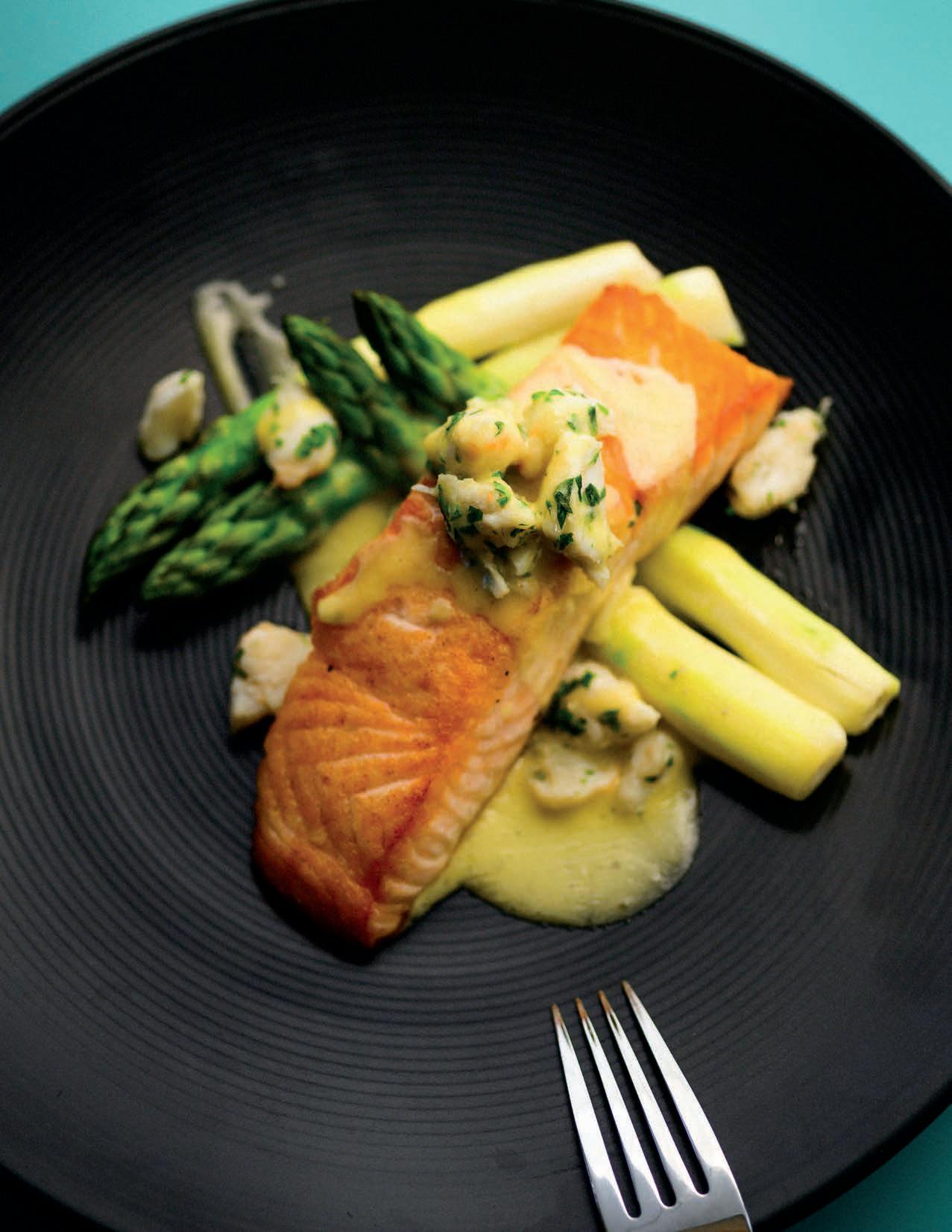
22 NCR | SEPTEMBER /OCTOBER 2019 | Classical vs. Modern |
Modern
“To make [salmon Oscar] unique to Hammock Dunes Club I wanted to keep the authenticity of the components but change up the presentation aspect of it, visually and for mouth feel,” Cook says. “How can I take these simple ingredients and present them in such a way that the diner leaves with it being not only delicious, but memorable, and they talk about for weeks and months later?”
With those ideas in mind, Cook took “modern” seriously, adding high-end presentation techniques for a wow factor.
“Anyone can cook asparagus and roll it in butter and seasoning. But why not layer flavors into a mousse-like consistency with garlic, shallots, cream, and [using a mold, make] it look like the original item,” he says. “[I changed the sauce] from béarnaise to hollandaise to simplify the profile, but then charged it with NO2 to give it an even more airy quality, changing the texture. I added a squid ink tuile for crunch, color, appeal [and] conversation.”
See the classical and modern recipes, as well as more photos, at wearechefs.com.

WEARECHEFS .COM 2 3
Photos by Miguel Emmanuelli
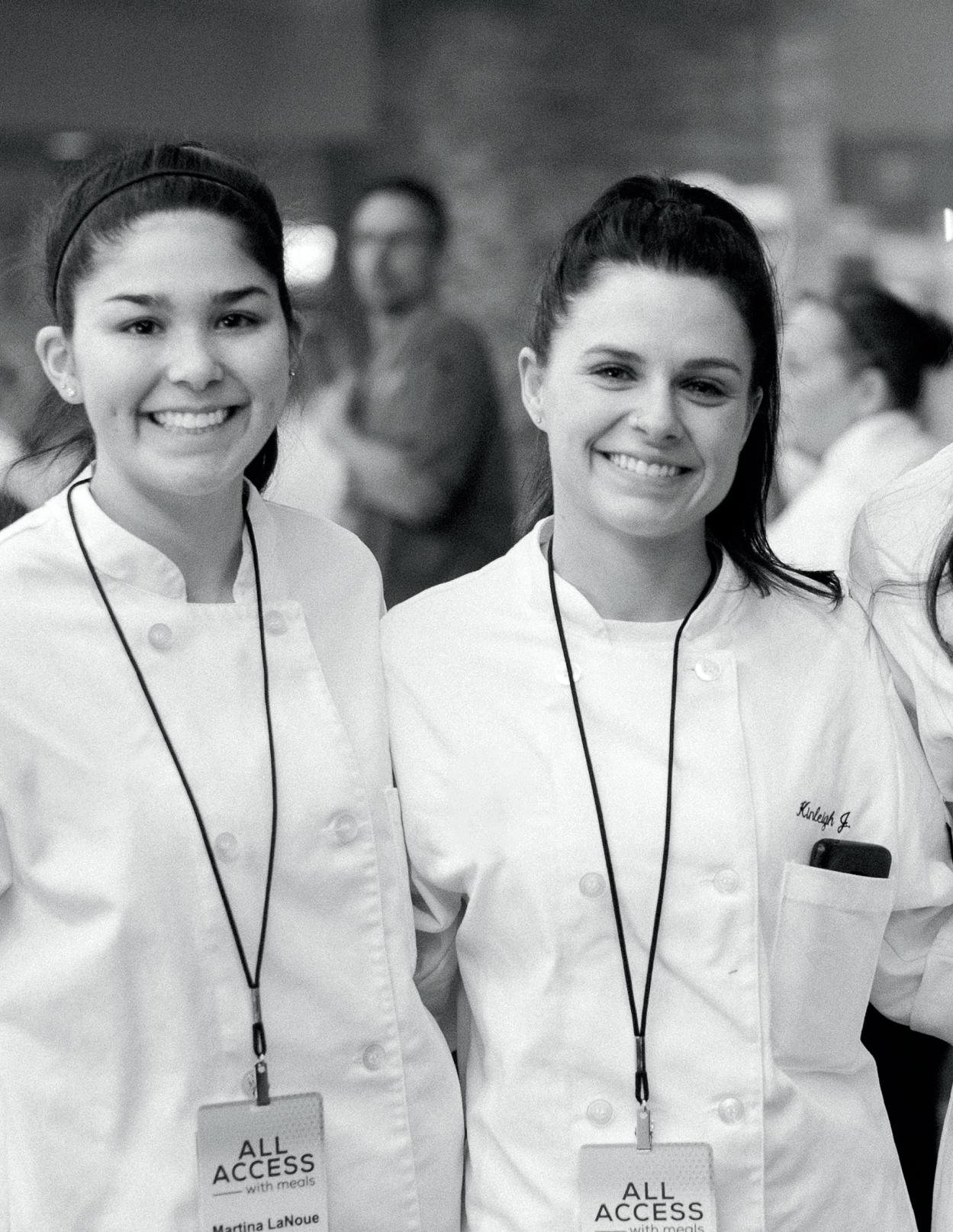


24 NCR | SEPTEMBER /OCTOBER 2019
The overwhelming majority of members of the American Culinary Federation are also members of one of the 170 ACF chapters around the world. Chapters are local groups with their own , and each one has a unique story to tell.

Sometimes we get emails or phone calls from members eager to share photos from their recent events. Sometimes we see a local news story detailing a fundraiser held by a chapter. But of course, chapters and their members do hundreds of great things every day and the news doesn’t make it to the National Office. They aren’t shouting it from the rooftops. They are just doing what they think is right for their members and for their communities.
In thinking about how the National Culinary Review could support these vital organizations, we decided to ask members to tell us about the great work that their chapter has done —


educating, mentoring, networking, learning, lending a hand to their fellow chefs, working with community leaders to promote the ACF and much more. Whatever you’ve done, we wanted to hear about it.
On the following pages, you’ll find the some of our favorite stories we received about chapters who take philanthropy seriously. We’ve also included inspiration for your next big recruitment drive or charity dinner, as well as advice on how to grow membership and reinvigorate dormant passion among the chefs in your town.
After you’re done reading, send us an email with some photos of your recent event or tell us the story of some members or students who flourished with chapter involvement. Because next year, we plan to be able to devote a lot more pages to the inspiring things ACF chefs can do when we unite.
WEARECHEFS .COM 2 5
GROWING MEMBERSHIP
ACF Cleveland has seen a spike in membership recently, with an increase of 40 members just in the last year. The chapter now has 203 members, up from 93 three years ago.
A lot of that is thanks to Chapter President John Selick (pictured above right), CEC, CCA, AAC, senior culinary manager at Sodexo Healthcare Services/University Hospitals, who has taken a very personal approach with members and prospective members alike when it comes to recruitment and retention.


“I like to send personal emails to members that have expired as well as chefs I know from the community rather than just a generic email asking them to come back,” he says.
Selick also gets rather detailed in his newsletters and communication with members and non-members, talking about all of the chapter’s activities and events and calling out members who have earned credentials to engage and entice people to get more involved. He uses an email marketing software to add details and photos. It also allows him to see who didn’t open the emails, a useful metric when reaching out personally later.
Selick also ACF-logoed greeting cards that he uses to hand write birthday cards for members and past members whose memberships have lapsed. He got the idea after a member sent him a handwritten birthday card. He also maintains an active Facebook page for the chapter with event listings, posts with links to cool things he sees, photos and recaps from competitions and more.
“I just try to make sure others know I am a person and not just on autopilot,” says Selick. “Too many members from other chapters have told me that when they became a member and didn’t hear from anyone in a year.”
COMING BACK FROM THE DEAD
The Cape and Islands Chefs Association dissolved years ago after having been one of the strongest ACF chapters in New England. Michael Pillarella, CEC, executive chef of the Wianno Club in Osterville, Mass., and Michael “Mickey” Beriau, CEC, AAC (a former member of the original chapter), re-formed the group about a year ago as president and vice president, respectively. Here are the lessons they learned when re-building ACF Cape Cod — good advice for anyone when forming a brand new chapter, too.
1. Go for grassroots: invite people initially and then ask them to bring friends, colleagues and industry peers next.
2. Pl an on spending five to seven hours a week when resurrecting a chapter. Set a little extra time aside to focus on opening a 501(c), as these take effort.
3. Have a meeting with a hook. Try educational offerings — for instance, Cape Cod organized a whole hog butchering demo and an event in a brewery with learning components presented by the Massachusetts Cheese Guild.

4. Ta rget members who were most active in the former chapter and surround yourself with talented and engaging people who will help lead your chapter.
5. Know your audience. If restaurants in your area are particularly busy in the summer due to tourism, for instance, consider scheduling meetings only during the offseason.
26 NCR | SEPTEMBER /OCTOBER 2019 | Chapters on a Mission |
PRESERVING HISTORY
The ACF Greater Indianapolis Chapter has established a Legacy & Historical Committee to document the history of their chapter and its earliest members. The committee is creating a series of mini-documentaries by recording interviews with older members who built up the chapter from the beginning, whom they call “Legacies.”


THERE’S AN APP FOR THAT
This past year, ACF Charlotte President Jay Ziobrowski (aka “Chef Jay Z”), corporate chef at InHarvest, partnered with a local marketing firm to develop an app that his members can use to connect and stay informed about events. The app, called ACF-CLT, can also be downloaded by non-members and prospective student members.

Prior to launch, Ziobrowski had several younger generation testers offer feedback on the user intuitiveness of the app, and this led to several improvements to make it as easy to use as possible.

Ziobrowski says the app has not only helped his chapter “stay cool” and relevant when it comes to enticing younger generation chefs and students to join, but it’s become a handy tool for engagement. Features include listings of chapter and industry events and meetups; local restaurant recommendations by chefs with menus for Charlotte visitors; ACF Charlotte and other chapter news, and soon-to-come fundraising promotions. The app also sends push notifications for event reminders and other information.
“We want to do this while they are still with us so that we can let them know our appreciation for what they have done to influence the industry and our chapter,” says David Kay, CCC, committee chair.
The first chef to be interviewed was Hubert Schmieder. He spoke on camera about his early life, retracing his steps from the start of his culinary career to emigrating to the United States in the 1950s to joining ACF Culinary Team USA in the 1960s. The next chefs to be filmed are Jurgen Jungbauer, Linda Shonk and Edmond Gass.
In addition to the docuseries, the chapter is working to collect historical memorabilia such as photographs and trophies that can be preserved to showcase the chapter’s history for years to come. A partnership with the Indiana Historical Society is in the works to assist with this project and the chapter hopes to find a museum that will display these important pieces of ACF history.
Charlotte isn’t the only one in on this game. Other chapters also have apps, including Palm Beach County and St. Louis. Check your app store to see if your local chapter has one, too.

CHAPTERS TO FOLLOW ON SOCIAL MEDIA
Need some ideas for creating a great social media presence for your chapter? Try following some of these groups who are betting big on Instagram:


WEARECHEFS .COM 2 7
REGIONS
■ Central
■ Northeast
■ Southeast
■ Western
■ International
members)
2019 National Chapter Achievement Award
High Honors
The Chapter Achievement Award honors chapters in good standing that strive for the highest level of excellence in all areas of chapter life, serving their members and their communities as well as supporting ACF's programs. This year’s winner was ACF Chefs de Cuisine Association of California (CCAC).
Exemplary chapters are chosen on a number of metrics, including whether they’ve conducted a new-member recruitment campaign in the last year; what social media channels they’re on; if they have a newsletter; how many chapter meetings they’ve held in the last year and more.
Applications for the 2020 Chapter Achievement Award are available on our website now at acfchefs.org/awards.
28 NCR | SEPTEMBER /OCTOBER 2019 |
|
Chapters on a Mission
ACF Kauai Chapter Smallest Chapter (12 members)
ACF Wichita Area Chapter Smallest Chapter (12
ACF Chefs de Cuisine Association of California
9,099 miles away
WEARECHEFS .COM 2 9
ACF Northwest Arkansas Chefs Association Newest Chapter (Chartered in August 2019)
ACF Philippines Farthest chapter from the National Office in St. Augustine, FL
ACF Greater Kansas City Chefs Chapter with the most students (220 students)
ACF Jamaica Newest Chapter (Chartered in August 2019)
ACF Korea Chapter Newest Chapter (Chartered in August 2019)
ACF Epicurean Club of Boston Oldest Chapter (founded in 1894!)
ACF Michigan Chefs de Cuisine Largest Single Chapter (427 members)
CHARITABLE ACTS
Professional Chefs Association of South Jersey
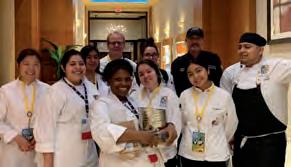
The South Jersey chapter was instrumental in planning and hosting the Chef:Connect in Atlantic City this past February. During the conference, the chapter held the ACF’s first-ever community outreach program at the Salvation Army.

Last year, the chapter also held four Chef and Child Initiatives in which members traveled to local schools and the Community Food Bank of South Jersey to teach and interact with the students about healthy eating and demonstrated how to prepare delicious, nutritious meals and snacks. In addition, the chapter held its annual Presidents Charity Scholarship Ball, attended by 360 people, and hosted a 16th annual Chefs at the Shore event with 35 local restaurants and chefs, raising money for culinary scholarships.
The chapter stays continually active in its local community by serving brunch for veterans, participating in Toys for Tots and by donating food and volunteers for local food bank fundraiser events.
ACF Big Apple
Over the past year, together with local colleges, the Big Apple Chapter (located in New York City, of course) has sent volunteer teams to support the Holy Apostle soup kitchen. Over the course of five events, the volunteers have helped serve more than 1,000 meals to people in need. Next year, the chapter plans to remain actively involved with the soup kitchen as well as further assist with fundraising. In addition, professional members, student members and volunteers worked together to host what turned out to be a very successful fundraising dinner at ChefConnect: Atlantic City.
ACF Tampa Bay Culinary Association

The 2019 World Chefs Without Borders (WCWB) Americas in Aid Fundraiser, hosted ACF Tampa Bay at the Fort Harrison Hotel in Clearwater, Florida, was the first WorldChefs fundraiser in the United States in March of this year. The event raised $40,000 to help WCWB with relief and food aid when natural disaster strikes. The chef team for the event included ACF Tampa Bay members as well as Fort Harrison Hotel chefs and local culinary students from Armwood and Bloomingdale high schools.
Earlier that week, ACF Tampa Bay teamed up with WCWB to prepare food for 263 people at St. Vincent de Paul Soup Kitchen. The chapter served Kalua pork with roasted broccoli, buttered corn, saimin soup, potato-mac salad, mixed greens with ginger dressing, sweet Hawaiian rolls with butter and pineapple foster cake with ice cream for dessert.
ACF Kauai
As one of the smallest chapters with just 12 members, ACF Kauai still remains regularly active in supporting their communities, with many members donating their time and services to the culinary program at The Kauai Community College as part of the chapter’s primary mission. Kauai chapter members also prepare food for 100 Salvation Army staff and volunteers twice monthly and also participate in a variety of fundraising events throughout the island that benefit many organizations including the culinary arts program. The chapter also supports an annual fundraising brunch for 2,000 people with food prepared by the culinary arts students and local chefs.
30 NCR | SEPTEMBER /OCTOBER 2019 | Chapters on a Mission |
Fresh, Quality Milk



Made from fresh, local milk gathered only a few hours after milking, BelGioioso Fresh Mozzarella, Burrata and Stracciatella begin with quality ingredients and care. The result is a delicate, clean-flavored Fresh Mozzarella with a soft texture and porcelain white appearance – the finest available on the market today. Try our new Stracciatella







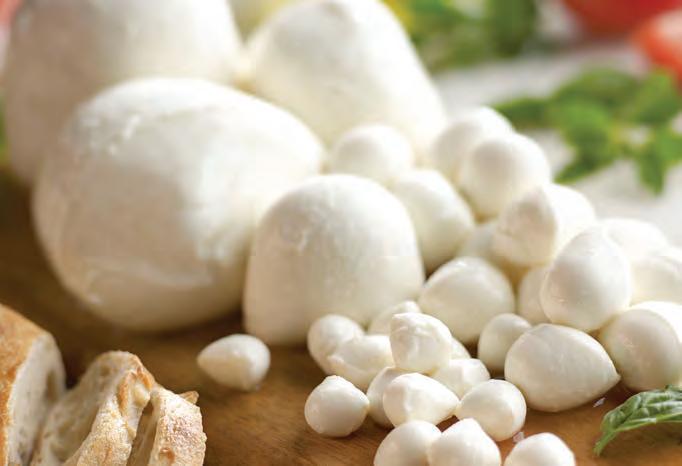


Available in waterpack tubs and cups, thermoform logs and balls, and slicing loaf.









OUR DIFFERENCE
belgioioso.com
BelGioioso Burrata filled with Stracciatella
BelGioioso Fresh Mozzarella
rBST Free* | Gluten Free | Vegetarian *No significant difference has been found in milk from cows treated with artificial hormones.
BelGioioso Stracciatella Tomato Appetizer
“The Heart of Burrata”
Giving Back
Charitable and philanthropic events are a win-win for restaurants.
By Rob Benes
Celebrity chefs and must-visit restaurants are now part of our national conversation on a daily basis. All that attention presents a unique opportunity.
“Chefs have been elevated in their social status, who can influence the way people eat and the way they think,” says Gregory Gourdet (pictured opposite center), culinary director for the Departure restaurants in Portland, Oregon, and Denver. “Chefs can use that influence for good and give back.”

Here are five examples of chefs and restaurants doing just that.
Working Class Outlaws
Metro Detroit-based Working Class Outlaws restaurant group donates between $10,000 and $15,000 a year to local charities. Most of the philanthropic work is done through artbased fundraising and through its four operations — Imperial, Imperial Taco Truck, Public House and Antihero. “It’s essential to include philanthropic events in your business plan, the restaurant’s mission and staff core values,” says Sagen Isham, marketing and events coordinator. “You also have to do a lot of planning to have a successful event that’s enjoyed by everyone attending, including staff.”
For the past six years, Imperial has held a charity skateboard auction (pictured top left) during the week of Cinco de Mayo, raising approximately

$3,000 each year. The restaurant provides local artists blank skateboard decks to decorate, which are then displayed in-house and auctioned on eBay. All proceeds go to a different organization each year, such as Detroit Hives, which establishes bee hives, and Haven, which helps women affected by domestic violence. This year, Imperial donated to Community Push, a non-profit that builds skateboard parks across Detroit.
The Keep
Human trafficking involves the use of force, fraud or coercion to obtain some type of labor or sexual exploitation. A study from the University of Cincinnati identified 1,032 victims between 2014 and 2016 and another 4,209 individuals at risk of being trafficked during the same period in Ohio’s urban centers, according to The Columbus Dispatch. The Keep, in Columbus, Ohio, takes the issue seriously.
On March 9, The Keep participated in Eat Up! Columbus, organized by Freedom a la Cart, which helps survivors of human trafficking. The event involved nine chefs, five mixologists and sponsors from around the city. Jonathan Olsen (pictured bottom left), executive chef, and Courtney Nielsen, chef de cuisine, represented The Keep and prepared one course of a six-course menu with drink pairings for 320 guests, held at St. Charles Preparatory School. With ticket sales and an auction, $40,000 was raised.
Olsen believes there are three benefits achieved from doing philanthropic work:
“First, working in restaurants is a high stress job, so to be able to step away for a short period of time and use our culinary skills to make a difference in people’s lives is rewarding and a short break from the daily grind. Next, when the kitchen staff works together on a charitable event it strengthens our bond as a team. Finally, without asking for recognition, the name of the restaurant gets noticed and we may see an increase in foot traffic.”
32 NCR | SEPTEMBER /OCTOBER 2019 | Management |
Tony Gemignani
For the past four years, San Francisco restaurateur Tony Gemignani has teamed up with San Francisco Giants players Joe Panik and Brandon Belt (pictured top right) to benefit the George Mark Children’s House by selling limited-edition pies created by each player.

The event starts at the beginning of the baseball season and finishes when the Giants’ season comes to an end. The Panik Parm Pie is topped with breaded chicken cutlets, sliced mozzarella, tomato sauce, garlic, grated Parmigiano-Reggiano, oregano and olive oil. Belt's Monster Meat Pizza features pepperoni, sausage, bacon, red and green onion, bell pepper, shaved Parmigiano-Reggiano and Romano cheeses, and a side of chili oil.
One dollar from each player's custom slice and $6 from each pie sold are donated to the charity. Having raised more than $30,000 since 2016, Gemignani continues to set higher fundraising goals with new locations where the custom pies are offered. The players quietly match what is raised, too.
“When I opened my first pizzeria, I sponsored youth baseball teams and donated $25 gift certificates,” says Gemignani. “I’m fortunate now to give back to larger organizations, as well as continuing to support smaller groups.”

Sundry and Vice
Doing philanthropic projects was not part of Stuart King’s initial business plan, but after his Cincinnati cocktail establishment, Sundry and Vice, gained a following he decided it was time. “Our approach to the success of Sundry and Vice is predicated upon the community, so it only made sense we support the community and give back,” he explains.
Sundry and Vice (pictured bottom right) maintains a long-term partnership with the non-profit organization Living with Change. The partnership has taken shape in the form of fundraiser nights and community engagement throughout the year to support the group’s mission of providing education and advocacy for the LGBTQ+ and transgender community. In 2019, the bar is hosting recurring guest speaker events that foster the education of trans rights and visibility. Money raised from these events will be donated to Living with Change.
Non-profit organizations often offer a guide to putting on charitable events, which can take pressure off of an operator who’s never done it before. “It’s a tremendous amount of work to plan and have a successful event,” King explains. “Working with a group that has a history of hosting charitable events helps in planning a successful event.”

WEARECHEFS .COM 3 3
Rob Benes is a Chicago-based hospitality industry writer. He can be reached at robbenes@comcast.net
RESTAURANTS AND FOOD ALLERGIES: MINIMIZING THE RISK
By Kelsey Casselbury
For more than a decade, health experts have been operating under the impression that somewhere between 11 and 15 million Americans suffer from food allergies of some sort. Equal to around 3.3 percent of the population, those estimates were nothing to scoff at. Which is why some chefs and restaurateurs took notice early that food allergies could affect their line of work.
Earlier this year, however, new numbers estimating the prevalence of food allergies came back. They were staggering. That previous estimate of 11 million wasn’t just a mere lowball — it was less than half of the actual statistic. Now, experts say, around 32 million Americans have food allergies, including 1 in 13 children. Additionally, anaphylactic food reactions increased 377 percent between 2007 and 2016, according to a review of insurance claim diagnoses.
Food allergies affect everyone, even those who don’t suffer from them personally. However, those who work in restaurants must be particularly mindful of the impact of food allergies
for both the safety of their customers and financial health of their business — sometimes going to the extreme. Jeff Jacobs, owner of Carroll’s Creek Cafe in Annapolis, Maryland, who has a son with severe food allergies, recently took the drastic step of completely eliminating all tree nuts and peanuts from the restaurant.

“It’s estimated there’s a loss of about $45 million each week, or $2 billion annually, from people avoiding restaurants [because of food allergies],” says Lisa Gabe, CEO of Food and Research Education (FARE). “If there’s a restaurant that’s the favorite of an athletic team, but there’s two athletes with allergies, you don’t just lose those two athletes — you lose the entire team, the parents and the fans.”
Therefore, she adds, if you get a reputation for being food allergy-friendly, it can be a net positive for the restaurant. To earn that reputation, though, everyone — from servers to chefs to owners to executives — must be on board with creating and following food allergy policies and procedures.
KNOW THE LAW
Of course, managing food allergies at a restaurant isn’t just about gaining a positive reputation. It’s also about complying with the appropriate laws, which are piling up across the U.S.
As of June 2019, six states and two cities have enacted legislation pertaining to food allergies in restaurants. Some are

You won’t find any peanuts or tree nuts in our kitchen! No IFs, ANDs or NUTS about it. 100% 34 NCR | SEPTEMBER /OCTOBER 2019 | Health |
As the prevalence of food allergies soars, servers, chefs and managers play a bigger role than ever in keeping customers safe.
//
simple, like requiring an allergy awareness poster in the staff area or a line on the menu that informs customers to alert their server to a food allergy. Others focus heavily on food allergy education. For example, in Illinois, all restaurants are required to have at least one manager on duty with food allergen safety training at all times of operation.

A small 2015 survey published in the Journal of Food Service Business Research found that 80 percent of chefs, managers and restaurant owners had had food allergy training. But there were still significant gaps in knowledge, such as being able to name soy and fish among the top eight allergens. Additional research published the following year in the Journal of Food Protection found that more than 10 percent of restaurant staff and managers incorrectly believed that a person with food allergies could safely eat a small amount of that allergen.
MINIMIZING RISK FROM FRONT TO BACK
The path to keeping customers safe from food allergies in a restaurant begins at the front of the house, says Keith Norman, assistant executive chef at South Point Hotel, Casino and Spa in Las Vegas and author of “Allergen Awareness: A Chef’s Perspective.” All staff at South Point goes through a five-hour training course with Norman, then is buddied with a veteran who knows specific food allergy policies and procedures.
However, in Norman’s experience, customers don’t necessarily offer up information chefs need to keep them safe. “What we’ve worked on with the front team is making guests feel comfortable” sharing their allergens and intolerances, Norman says. “You have to make them feel welcome.”
Norman notes that he doesn’t train the FOH staff to ask about allergies, noting that when they initially did that, there was pushback from the guests. Instead, they look for trigger words. “Say you come into the restaurant and have a dairy allergy,” he posits. “You order chicken marsala and ask if there’s cheese in the dish. You gave an indication that there’s a problem, and we’re going to take it from there.”
When the order moves from the front of the house to the kitchen, additional procedures are in place. The POS system prints the order to the kitchen in bright red, so there’s no chance of missing the information.
Next, the culinary staff uses an allergen kit that’s in the kitchen to prepare the meal. “The gloves come off, the hands are washed, and the purple gloves go on,” he says. (Purple has become the defacto color choice for allergen-free equipment in commercial kitchens.)
When the team at Carroll’s Creek Cafe began to research eliminating nuts about two years ago, they knew the process wasn’t going to be easy. “It’s not just ordering the nuts,” Jacobs says. “It’s finding all the places where there could be cross-contamination. What scared us the most is that we didn’t know where to look.”
In the end, the restaurant worked with a consulting firm to figure out where to look. The hardest part, he notes, was replacing the desserts, particularly the ice cream. However, the community feedback — nothing but praise — has been worth the effort.
“We didn’t see a downside” to eliminating nuts from the restaurant, Jacobs says. “We only saw the upside.”
WEARECHEFS .COM 3 5
Kelsey Casselbury is a freelance writer based in Odenton, Maryland. Find more of her work at kelseycasselbury.com.
“
IT’S FINDING ALL THE PLACES WHERE THERE COULD BE CROSSCONTAMINATION. ”
The World’s Best Bartender Gets Sober
 By Amy Paturel, MS, MPH
By Amy Paturel, MS, MPH
Jack McGarry (pictured above) was only 23 in 2013 when Tales of the Cocktail named him International Bartender of the year – the bar industry equivalent of winning an Oscar for Best Director. Not only was he the youngest person to ever receive the honor, but Dead Rabbit, the New York City bar he co-founded with buddy Sean Muldoon, won just about every award the industry has to offer, including “World’s Best Bar” in 2015.

But unlike most in his profession, you won’t find McGarry sipping a cocktail. Sober for more than three years, he has become a beacon of hope for others in the industry who are battling substance abuse.
We asked McGarry how he got clean and how his relationship with alcohol has changed.
Q: When did you know your drinking was getting out of hand?
A: I knew something was wrong as soon as I came off the stage three months after we opened Dead Rabbit. The bar won three awards, I had achieved my personal dream of best bartender and I felt nothing. But I didn’t hit bottom until I woke up in the hospital on March 25, 2016. The night before, I had gone out on the pier and got drunk. I picked up
sleeping tablets on my way home hoping to just end it all.
Q: What did getting sober look like for you?
A: I have to manage the disease with ongoing therapy and AA. In recovery, I was in outpatient rehab for three or four hours a day, which lasted for almost a year. Now, I have a rigid structure in place to make sure I don’t fall back. I’m also a huge fitness person, which helps me stay on track. But it is a battle. I have to wake up and take each day as it comes. “Today, I’m not going to drink.” Then it just becomes a cumulative thing.
Q: How do you hope the industry will change to address mental health?
A: When I came out of the hospital, nobody talked about mental health. I knew I had a platform to raise awareness about mental health issues within our industry. I had a beautiful girlfriend. I was financially secure. I had good health coverage and I had the support that I needed. Most bartenders don’t have health insurance or the means to recover. So my goal has always been to get bartenders and restaurant professionals diagnosed and then connect the dots to help them get the resources they need, whether that’s medication, rehabilitation or some type of structured recovery. Unfortunately, we’re still a ways off from that.
Read more of McGarry’s story on wearechefs.com.
36 NCR | SEPTEMBER /OCTOBER 2019 | Health |
Amy Paturel, M.S., M.P.H., lives in Murrieta, California, where she writes about food, health and wellness.

















If you are suffering from chronic pain or loss of function and it’s affecting your quality of life, we have centers across the U.S. that are ready to help you find out if these new treatments could improve your life. or call 888.414.STEM Go to www.StemHotline.com FOR YOUR COMPLEMENTARY CONSULTATION $500 Credit Voucher Credit towards any Regenerative Medicine Treatment scheduled at time of exam www.rmaai.com Foodservice Distributor Since 1925 Ocala 800-939-4018 Punta Gorda 844-234-1341 Statesville 800-899-3921 WWW.CHENEYBROTHERS.COM GEORGIA Tifton 833-424-3639 DELIVERING HOMEGROWN FLAVORS FROM THE NORTH CAROLINA GEORGIA FLORIDA
The Recipe for a Great

Want to know what made ACF National Convention: Orlando 2019 so amazing? Here's our secret recipe...





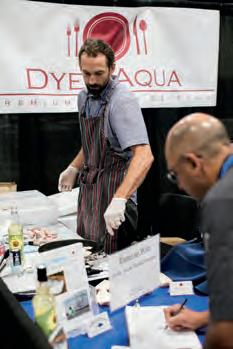



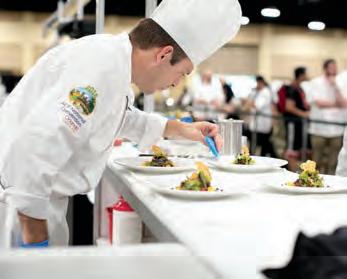

1,300 attendees (and 100+ first timers!)
Convention See all our photos from Convention at flickr.com/acfchefs
9 feet of cake

100 national competitors
40+ presenters



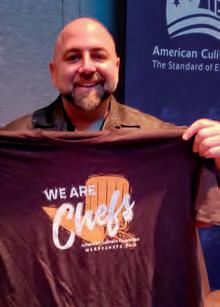

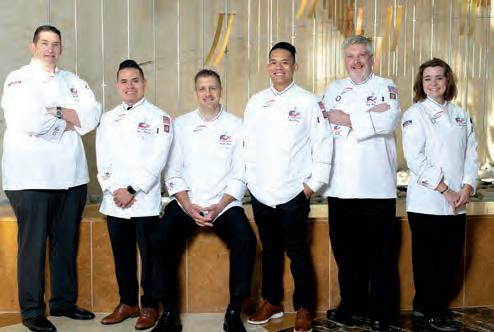










2 ACF National Culinary Teams 3 VIP experiences (all sold out) 24 inch biceps of Chef Andre Rush 130 vendors Mix it up and enjoy! Early registration pricing for 2020 ACF events in Nashville, Seattle and Dallas is available right now! Visit acfchefs.org/events to register today.
2019 ACF National Award Winners




Congratulations to the following winners who competed for national titles at ACF's 2019 National Convention in Orlando.

USA’S CHEF OF THE YEAR
Sponsored by Centerline Brackets
REILLY MEEHAN, CEC
STUDENT CHEF OF THE YEAR
Sponsored by Libbey
HITOMI TOMOBE
CHEF EDUCATOR OF THE YEAR
SCOTT STEINER, CCE, AAC
PASTRY CHEF OF THE YEAR
Sponsored by KitchenAid
SSG SAMANTHA POE
STUDENT TEAM OF THE YEAR
Sponsored by R.L. Schrieber Inc.
BARON H. GALAND CULINARY KNOWLEDGE BOWL CHAMPION
OREGON COAST CULINARY INSTITUTE
Coaches: Randy Torres, CEC; Laura Williams, CEC
Captain: Brock Mahi
Vicki White
Bradleigh Best
Marissa Brazell
Grace McKie
Andy Wright
Evan White
Jerry Martinez
Hunter Robbins-Bilow
CULINARY INSTITUTE OF MICHIGAN AT BAKER COLLEGE
Coach: Amanda Miller, CC, CPC
Captain: Stanley Mersino
Co-captain: Rachelle Murphy
Kate Strauss
Camryn Potter
CHAPTER OF THE YEAR
ACF CHEFS DE CUISINE ASSOCIATION OF CALIFORNIA
REGION OF THE YEAR
CENTRAL
DR. L.J. MINOR CHEF
PROFESSIONALISM AWARD
Sponsored by Minor’s
RICHARD HOFFMAN, CEC, CCA, AAC


HERMANN G. RUSCH CHEF’S ACHIEVEMENT AWARD
JOHN FOLSE, CEC, AAC, HOF

40 NCR | SEPTEMBER /OCTOBER 2019 | Award Winners |
INDUSTRY PARTNER AWARD
SMITHFIELD CULINARY
SPIRIT OF ALOHA AWARD
GEOFFREY BLOUNT, CEPC
ANTON DOOS, III, CEC
JEFFREY ROTZ, CEC, CCE, AAC
GIOVANA SANCHEZ
BILL SY, CEC, AAC, HOF
ACF ATLANTIC CITY CHAPTER
PRESIDENTIAL MEDALLION
YVONNE ANDERSON-THOMAS
SANDRA BIRMINGHAM
KIMBERLY BROCK-BROWN, CEPC, CCA, AAC
ELENA CLEMENT, CEPC, AAC
CHRISTOPHER DONATO, CEC, AAC
KEVIN ENRIGHT, CEC, CCE, AAC
NORALYN GALDIANO, CEC, AAC
BRIAN HARDY, CEC, CCA, AAC
JEREMIAH LANES, CC
THOMAS MACRINA, CEC, CCA, AAC
EVA MAGOULAS, CEC, CCE, CCA, AAC
TRACY MORRIS, CWPC
RAJEEV PATGAONKAR, CEC, AAC
VICTOR SOMMO, CEC
SAMUEL SPENCER
ROCCO PARADISO
KYLE RICHARDSON, CEC, CCE, AAC
JULIA SPONDIKE, CFC
PETER VOSSENBERG, CEC, CCE, CCA, AAC
ACHIEVEMENT OF EXCELLENCE AWARD
MR. GREENS PRODUCE, Orlando, FL
SHAWN LOVING, Schoolcraft College, Livonia, MI
G. LUCIEN SALAMA, New Chef Fashion Inc., Los Angeles, CA
GEORGIOS KASTANIAS, Moore Foods Distributors, St. Louis, MO
ANA LEBRON CORRERE, SRL Catering Services, Dominican Republic
SCOTT CRAIG, Myer’s Park Country Club, Charlotte, NC
DEVAKI PRATT, Dominican Republic
AASHIRWAD INDIAN FOOD, Orlando, FL
JOHN KUKUCKA, Windsor Country Club, Ontario, Canada
ANITA CHENG, Hong Kong
JORGE ORTEGA, CHILE
TOMAS LOPEZ ARMENDARIS, Academia Culinaria del Pacífico, Ecuador
ADDIEMAE FARRINGTON, Bahamas Culinary Institute, Bahamas
CAROL ROSE BROWN, Jamaican Tourist Board, Jamaica
HYCUBE, Orlando World Center Marriott, Orlando, FL
DULCE MIRIAM MENDOZA CRUZ, M&M Bake Shop
IRMA ACUÑA, Libbey, Toledo, OH
TRACY SMITH, Centerline Brackets, St. Augustine, FL
ACF INTERNATIONAL LIFETIME MEMBER MEDALLION
ANITA CHENG, HONG KONG
JORGE ORTEGA, CHILE
DULCE MIRIAM MENDOZA CRUZ, MEXICO
TOMAS LOPEZ ARMENDARIS, ECUADOR
YOUNG HO LEE, SOUTH KOREA
ADDIEMAE FARRINGTON, BAHAMAS
WEARECHEFS .COM 41
2019 AMERICAN ACADEMY OF CHEFS INDUCTEES
The American Academy of Chefs (AAC), the honor society of the American Culinary Federation, recognizes those ACF members who have met rigorous requirements and whose culinary achievements and involvement in ACF qualify them for Fellowship in this prestigious society. Below are the names of this year’s inductees, honored at the AAC dinner on August 4, 2019.

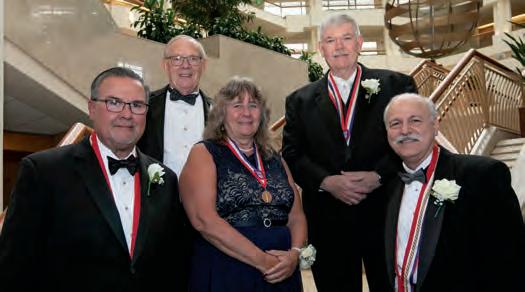
2019 AWARD RECIPIENTS
Each year, the Academy honors dedicated Fellows with its most prestigious awards. Here are the 2019 recipients.
2019 Chair’s Medal
Linda S. Musch, CCE, AAC
2019 Lawrence A. Conti, CEC, AAC, HOF, Chair's Achievement Award
William J. Tillinghast, MBA, CEC, AAC
2019 Joseph Amendola Award
Garry W. Waldie, CEC, CEPC, CCE, AAC
2019 Lt. General John D. McLaughlin Award
Jeffrey P. Lein
2019 Chef Good Taste Award
Deborah A. Bando-Duit, CEC, AAC
2019 Sharing Culinary Traditions Award Recipient
Costa N. Magoulas, CEC, CCE, CCA, AAC
2019 CULINARY HALL OF FAME INDUCTEES
Joe G. Aiello, CEC, AAC, HOF
Luigi G. Baretto, CEC, AAC, HOF, Emeritus
Michael L. Minor, CEC, AAC, HOF, Emeritus Honorary
Frank J. Setera, CEC, AAC, HHOF, Emeritus
Posthumous
Michel D. Bouit, CEC, AAC, HOF
Christopher J. Neary, CEC, CCA, AAC, HOF
2019 Culinary Hall of Fame
Celebrated Chef Gale Gand
2019 AMERICAN ACADEMY OF CHEFS FELLOWS
Jeremy J. Abbey, CEC, CEPC, CCE, CCA, AAC ACF Michigan Chefs de Cuisine Association
Kerry J. Beadle, CEC, CCA, AAC ACF Syracuse New York Chapter
Robert E. Brantly, CEC, AAC ACF Myrtle Beach Chapter
Paul G. Brennen, Ed.D., CEC, CCA, AAC ACF Middle Tennessee Chapter
Paul N. Brown, CEC, CCA, AAC ACF Nation’s Capital Chefs Association
Jim Churches, CEC, CCA, AAC ACF Chefs de Cuisine Association of California
Richard J. Crisanti, CEC, CCA, AAC ACF Caxambas Chapter of Southwest Florida
Johnny W. Curet, CEC, AAC Texas Chefs Association
42 NCR | SEPTEMBER /OCTOBER 2019 | American Academy of Chefs |
Alexandra Alfano Higgins, CEC, AAC ACF Chefs de Cuisine Association of California
Maria B. Iacovitti, CEPC, AAC ACF of Greater Buffalo New York
Richard R. Kugelmann, CEC, CCA, AAC American Culinary Federation Chefs of Charlotte Inc.
Kurt A. Kwiatkowski, CEC, CCA, AAC ACF Michigan Chefs de Cuisine Association
Gary T. Lyons, CEC, AAC ACF Fox Valley Chapter
Robert W. Marilla, CEC, AAC American Culinary Federation Chefs of Charlotte Inc
Ray J. McCue, CEC, AAC ACF Rhode Island Chapter
John Miller, CEC, CCA, AAC
ACF Michigan Chefs de Cuisine Association

Andreas Proisl, CEPC, AAC ACF Central Florida Chapter
John Selick, CEC, CCA, AAC ACF Cleveland Chapter Inc
Ben Simpkins, CEC, CCA, AAC ACF Palm Beach County Chefs Association
Robert Walljasper, CEC, CCE, AAC ACF Big Apple Chapter
2019 HONORARY INDUCTEES

Honorary Fellowship in the Academy is conferred upon individuals in recognition of their dedication and service to the culinary profession, as well as for their enhancement of the culinary arts through their unique accomplishments.
John Burson, HAAC
Membre du Conseil Magistral, Chaîne des Rôtisseurs Toledo, Ohio
Luis Del Cid, HAAC
Director, Academia Culinaria de Guatemala Henderson, Nevada
John Johnstone, CMC, HAAC Vice President, Food & Beverage, The Broadmoor Colorado Springs, Colorado
Liu Gwangwei, HAAC
President of Bejing Eatology Research Institute; Chinese Master Chef; Chinese Culinary Culture Master Bejing, China
Scott R. Paul, HAAC
Southeast Regional Sales Manager/ Corporate Chef, BelGioioso Cheese Inc. Indian Trail, North Carolina
Mary Petersen, HAAC
President, Center for the Advancement of Foodservice Education Annapolis, Maryland
Craig Youdale, HAAC
Dean, Canadian Food and Wine Institute, Niagara College Niagara-on-the-Lake, Ontario, Canada
James T. Young, CCC, HAAC, Emeritus Executive chef, retired West Yarmouth, Massachusetts
WEARECHEFS .COM 4 3
NCR Quiz
September/October 2019
By LeeAnn Corrao
The “Oscar” component of Veal Oscar consists of
a. green beans and crab meat topped with Béarnaise sauce
b. asparagus and crab meat topped with Béarnaise sauce

c. crab meat or lobster topped with browned butter
d. roasted asparagus topped with Hollandaise sauce
Living With Change’s mission is to .
a. Raise money for communities devastated by natural disasters
b. Provide quality of life and community care for children with illnesses
c. Provide education and advocacy for the LGBTQ+ community
d. None of the above
In 1939, the role of chef was still considered a part of the service class, and hadn’t yet been elevated to “professional” status by the Department of Labor.
a. True
b. Fal se
What was the goal of the first Culinary Congress in 1939?
a. To unite all of America’s chefs
b. To g ive America’s chefs a strong voice
c. To structure the ACF into a single organization
d. Both A and B
An estimated Americans suffer from food allergies.
a. 11 million
b. 15 mil lion
c. 26 mil lion
d. 32 mil lion
Which of the following is a benefit of buying custom plateware?

a. Adds an extra layer of texture of any dish
b. Gets your customers talking
c. Su pports local artisans
d. Al l of the above
Green tomato pie has a similar flavor to
a. Pear Chess Pie

b. Green Apple Pie
c. Carrot Cake
d. Sp ice Cake
How often does Leonard Hollander change the entire dinner menu at Arbor?

a. Every week
b. Every two weeks
c. Every month
d. Every season
Michael Ruhlman co-wrote The French Laundry Cookbook with what other chef?
a. Gale Gand
b. Thomas Keller
c. Br ian Polcyn
d. Jennifer Hill Booker
44 NCR | SEPTEMBER /OCTOBER 2019 | Quiz |
the rest of the questions, finish the quiz and earn 4 CEHs toward your certification on ACF’s new Online Learning Center at acfchefs.org/olc.
See
Tips and Tricks for Publishing that First Cookbook

How to avoid common missteps that could foil your first cookbook
By Jody Shee
As chefs in a media-focused world, you might have felt driven to publish your recipes in a cookbook. We asked a few authors to share the mistakes they made and advise others how to avoid similar blunders.
Don’t assume readers know how to cook. Lilburn, Ga.-based Jennifer Hill Booker, CEC, culinary educator and author of two Southern cuisine-themed cookbooks, admits she assumed too much of the reader at first. “You have to spell everything out, like the size of the bowl, how much water to put in the stock pot and how long to boil it,” she says.


a restaurant, but it wasn’t how someone at home wants to cook,” she says. She advises first-timers to keep recipes to eight ingredients or less.
the research, says Brian Polcyn, CEC, culinary instructor at Schoolcraft College in Livonia, Mich., and co-author of three charcuterie-themed cookbooks. “Validate everything you say. Once you put it in words, it better be right.”
Professionalism also means getting others to test the recipes and potentially hire a professional writer. To find one, contact local newspaper food writers. “Chefs are cooks and usually are not great writers, and they are busy,” Ruhlman says.

Don’t expect publishers to be interested in your cookbook. They are inundated with book proposals. “Be able to answer why this cookbook needs to happen,” says Ruhlman. “What does it add to an already overcrowded field of cookbooks? Find a book agent to help you with your proposal and pitch it to publishers.”
Don’t make your recipes too unapproachable. Gale Gand, Chicagobased pastry chef, cooking teacher, TV personality and author of nine cookbooks, admits that the ingredient lists of the recipes in her first cookbook were too long. “Each recipe included every ingredient as a chef would use in


Don’t take a shotgun approach with your recipes. Pick a theme or a hook for your cookbook. It’s not good enough to simply fill a book with recipes, says Michael Ruhlman, author and co-author of 25 books. His first solo book was Ruhlman's Twenty: 20 Techniques, 100 Recipes, A Cook's Manifesto Due out in October, Ruhlman’s next book also has a captivating theme, From Scratch: 10 Meals, 175 Recipes and Dozens of Techniques You’ll Use Over and Over
Don’t slack on professionalism. Whatever your cookbook theme or concept, don’t assume you already have all the knowledge. Delve into aspects with which you are unfamiliar and do

WEARECHEFS .COM 4 5 | Main Course |
Jody Shee, a Kauai, Hawaii-based freelance writer and editor, previously was editor of a foodservice magazine. She has more than 20 years of food-writing experience and writes the blog www.sheefood.com.
Photo credits: Brian Polcyn, CEC photo by Joe Vaughn; Michael Rulhman photo by Catherine Sebastian
Acts of Congress
By Heather Henderson
Ten years after the founding of the American Culinary Federation, as war raged just on the other side of the ocean, chefs gathered in New York City to celebrate cooking and camaraderie. It was the first Culinary Congress, held at the Waldorf-Astoria Hotel on November 6-9, 1939.
At that time, the ACF was structured differently. Rather than a single organization with local chapters all flying the ACF banner, the organization was an umbrella institution over a number of groups, including the Chefs de Cuisine Association of America, Société Culinaire Philanthropique, the Vatel Club and others.

The Culinary Congress was the precursor to today’s ACF National Convention. But it was quite different from the events we know today. At the National Convention in Orlando this year, a diverse crowd of more than 1,300 chefs took part in exciting demonstrations and workshops, enjoyed delicious food, enjoyed live music and generally had a lot of fun.
The first Culinary Congress was a somewhat stuffier affair: a few hundred men gathered to discuss matters of business. In 1939, the role of chef was still considered a part of the
service class, and hadn’t yet been elevated to “professional” status by the Department of Labor. The chefs who made up the ACF and its subsidiaries at that time felt underrepresented and forgotten. The goal of the Congress was to unite all of America’s chefs to give them a strong voice. Joseph Frederique, then President of the Chefs de Cuisine Association of America, spoke at the event, saying, “We are out to make our profession greater and better known. We want to do our share in the activities of this great and busy nation which takes good food for granted.”
During the three-day conference, the chefs discussed problems facing their profession, and voted on new ways to move things forward. They debated over whether the ACF should begin sponsoring apprenticeships, whether menus should be written in English rather than French to allow the American public to understand what they were ordering, and discussed how sanitation standards could be improved. Eventually, they agreed to form an apprenticeship committee, use standardized English culinary terms, and create a committee to appoint some chefs as sanitation inspectors. They also established steps to expand the ACF and invite in more culinarians, including bakers, butchers and pastry chefs, to strengthen the organization.
Though the event was light on celebrity speakers, competitions and parties, the First Culinary Congress clearly laid the foundation for today’s ACF and the culinary profession in America as we now know it.
46 NCR | SEPTEMBER /OCTOBER 2019 | A Look Back |
Above: Attendees of the First Culinary Congress at the Waldorf-Astoria Hotel on November 6, 1939















































C M J CM MJ CJ CMJ N AD BASQUE CHEESE 7.375X4.5-01 vecto HD.pdf 1 12/04/2019 09:01 With Conference On-Demand, you can relive every exciting moment from 2019 ACF ChefConnects and National Convention. Visit acfchefs.org/olc today! NEVER MISS A MOMENT
Thank You to Our Sponsors













CHEF
DE CUISINE EXECUTIVE CHEF INSPIRATION
PATISSIER SOUS
SAUCIER CHEF
































































































































































































 CAMPAIGN FINANCED WITH AID FROM THE EUROPEAN UNION.
THE EUROPEAN UNION SUPPORTS CAMPAIGNS THAT PROMOTE HIGH QUALITY AGRICULTURAL PRODUCTS.
CAMPAIGN FINANCED WITH AID FROM THE EUROPEAN UNION.
THE EUROPEAN UNION SUPPORTS CAMPAIGNS THAT PROMOTE HIGH QUALITY AGRICULTURAL PRODUCTS.





















































































 By Kathryn Kjarsgaard
By Kathryn Kjarsgaard












 Robert Wemischner
Robert Wemischner






















































 By Amy Paturel, MS, MPH
By Amy Paturel, MS, MPH





















































































































